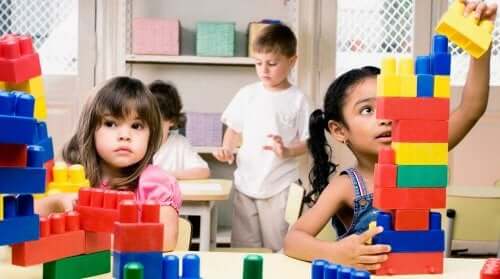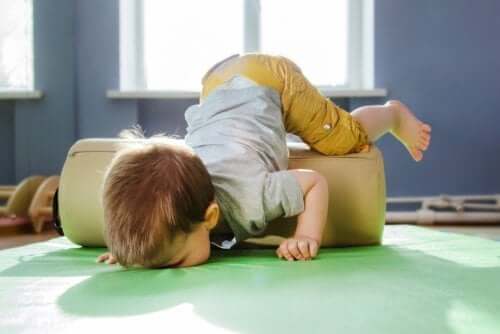The Characteristics of Psychomotor Rooms

Stimulating psychomotricity, especially in children, should take place in a well-planned and systematic fashion. This guarantees a child’s proper development and growth. And this is why the characteristics of psychomotor rooms should be adequate and coherent in regards to their proposed objectives.
At the same time, the different areas of development that come into play in a person’s maturity influence each other and interact constantly. These areas include a person’s physical, intellectual, social and affective development.
Therefore, proper development on a psychomotor level is fundamental in obtaining progress in every other aspect of growth.
What is psychomotricity?
Psychomotricity is a discipline involving the relationship between the mind, psyche, and a person’s ability to move, i.e. motor function. Techniques are based on a holistic conception of the individual and help to develop body movement, communication, and body language with others and with the environment.
Psychomotricity involves gross motor development and the movement of large muscle groups that are fundamental in locomotion and posture. Furthermore, it involves fine motor development, which involves small muscles, like those of the fingers and wrists.
All of this takes place in a progressive manner. In other words, new knowledge builds on top of already acquired knowledge.

Exercising psychomotricity in children helps them become more aware of their own bodies through the acquisition of their body scheme. As a result, they’re more able to control their bodies and dominate and adapt their movements.
Hence, proper psychomotor development should work on the following areas:
- Laterality.
- Posture.
- Balance, or equilibrium.
- Coordination.
- Location in space and time.
Characteristics of psychomotor rooms
To put together a psychomotor room, it’s important to have a clear understanding of the educational and therapeutic goals and objectives of each activity. What’s more, you should choose and adapt your materials accordingly.
Below are the most important characteristics of a psychomotor room:
- There should be plenty of space, good lighting, ventilation, and a comfortable temperature. What’s more, pay attention to decoration and ambiance, as these factors influence a person’s state of mind.
- The room should satisfy optimal child safety conditions. In other words, the room and its contents should pose no risk for little ones. In this sense, it’s important to take things like electrical outlets, slopes, steps, windows, etc. into consideration.
- Psychomotor rooms should consist of a place where children make psychomotor progress through related games and activities. Furthermore, specific planning should guide these activities, according to the psychomotor aspects that require stimulation.
- Psychomotor rooms should contain suitable and well-chosen materials. Of course, there are some materials that are more specific than others, depending on concrete exercises and goals. However, the following items are essential:
-
- Mats.
- Art supplies (tempera paints, crayons, play dough, pencils, watercolors, paper, etc.)
- Large foam rubber cubes, noodles, wedges, etc.
- Wooden benches or steps for jumping.
- Mirrors.
- A variety of balls of different sizes, made of different materials.
- Fabric and cushions.
- Colored hula hoop rings.
- Building materials (wooden blocks, assembly blocks, etc.).
What’s more, any item that has some didactic purpose is welcome in a psychomotor room. For example, old clothing and fabric, plastic bottles, boxes and cardboard, and any material that children can use to exercise and develop psychomotor abilities.

In conclusion…
The most important aspect of psychomotor rooms for working with children is that they offer a warm environment and suitable materials.
What’s more, there must be a programmed, mediating action on behalf of educators or professionals that guides children towards achieving the maximum development of their psychomotor abilities.
Stimulating psychomotricity, especially in children, should take place in a well-planned and systematic fashion. This guarantees a child’s proper development and growth. And this is why the characteristics of psychomotor rooms should be adequate and coherent in regards to their proposed objectives.
At the same time, the different areas of development that come into play in a person’s maturity influence each other and interact constantly. These areas include a person’s physical, intellectual, social and affective development.
Therefore, proper development on a psychomotor level is fundamental in obtaining progress in every other aspect of growth.
What is psychomotricity?
Psychomotricity is a discipline involving the relationship between the mind, psyche, and a person’s ability to move, i.e. motor function. Techniques are based on a holistic conception of the individual and help to develop body movement, communication, and body language with others and with the environment.
Psychomotricity involves gross motor development and the movement of large muscle groups that are fundamental in locomotion and posture. Furthermore, it involves fine motor development, which involves small muscles, like those of the fingers and wrists.
All of this takes place in a progressive manner. In other words, new knowledge builds on top of already acquired knowledge.

Exercising psychomotricity in children helps them become more aware of their own bodies through the acquisition of their body scheme. As a result, they’re more able to control their bodies and dominate and adapt their movements.
Hence, proper psychomotor development should work on the following areas:
- Laterality.
- Posture.
- Balance, or equilibrium.
- Coordination.
- Location in space and time.
Characteristics of psychomotor rooms
To put together a psychomotor room, it’s important to have a clear understanding of the educational and therapeutic goals and objectives of each activity. What’s more, you should choose and adapt your materials accordingly.
Below are the most important characteristics of a psychomotor room:
- There should be plenty of space, good lighting, ventilation, and a comfortable temperature. What’s more, pay attention to decoration and ambiance, as these factors influence a person’s state of mind.
- The room should satisfy optimal child safety conditions. In other words, the room and its contents should pose no risk for little ones. In this sense, it’s important to take things like electrical outlets, slopes, steps, windows, etc. into consideration.
- Psychomotor rooms should consist of a place where children make psychomotor progress through related games and activities. Furthermore, specific planning should guide these activities, according to the psychomotor aspects that require stimulation.
- Psychomotor rooms should contain suitable and well-chosen materials. Of course, there are some materials that are more specific than others, depending on concrete exercises and goals. However, the following items are essential:
-
- Mats.
- Art supplies (tempera paints, crayons, play dough, pencils, watercolors, paper, etc.)
- Large foam rubber cubes, noodles, wedges, etc.
- Wooden benches or steps for jumping.
- Mirrors.
- A variety of balls of different sizes, made of different materials.
- Fabric and cushions.
- Colored hula hoop rings.
- Building materials (wooden blocks, assembly blocks, etc.).
What’s more, any item that has some didactic purpose is welcome in a psychomotor room. For example, old clothing and fabric, plastic bottles, boxes and cardboard, and any material that children can use to exercise and develop psychomotor abilities.

In conclusion…
The most important aspect of psychomotor rooms for working with children is that they offer a warm environment and suitable materials.
What’s more, there must be a programmed, mediating action on behalf of educators or professionals that guides children towards achieving the maximum development of their psychomotor abilities.
All cited sources were thoroughly reviewed by our team to ensure their quality, reliability, currency, and validity. The bibliography of this article was considered reliable and of academic or scientific accuracy.
- Bottini, P. (2000). Psicomotricidad: práctica y conceptos. Editorial Miño y Dávila. Madrid.
- Lázaro, A. L. (2008). Estimulación vestibular en educación infantil. Revista interuniversitaria de formación del profesorado, (62), 165-174. https://dialnet.unirioja.es/descarga/articulo/2707438.pdf
-
Lázaro, A. L. (2015). El influjo psicomotor en los aprendizajes escolares. Padres y Maestros/Journal of Parents and Teachers, (364), 34-39. https://revistas.comillas.edu/index.php/padresymaestros/article/view/6346
- Maganto, C. y Cruz, S. (n.d.). Desarrollo físico y psicomotor en la primera infancia. Recuperado de http://www.sc.ehu.es/ptwmamac/Capi_libro/38c.pdf
- Silvestre, N. E. P. (2011). La psicomotricidad y la construcción del espacio. Scientia, 1(1). http://50.28.16.6/investigacion/pdf/1.5.pdf
This text is provided for informational purposes only and does not replace consultation with a professional. If in doubt, consult your specialist.








